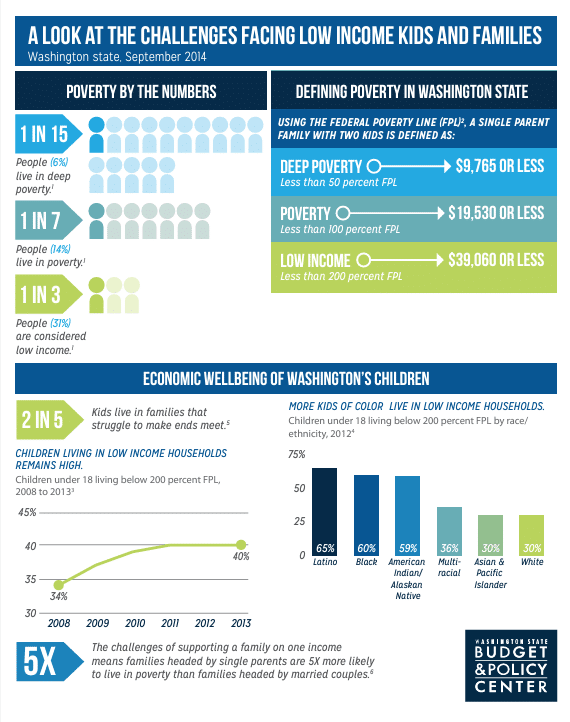New Census data released today shows that Washington state was one of a handful of states where poverty increased between 2012 and 2013, while median income remained stagnant. The new numbers shed further light on the state’s uneven economic recovery and should serve as a call-to-action for lawmakers.
Washington state, New Jersey, and New Mexico were the only three states to see an increase in the total number of people living in poverty. Washington state-specific data include (see fact sheet):
- One in seven people (14.1 percent) live below the poverty line. This is up from 13.5 percent in 2012. For a family of three, the poverty line is defined as earning less than $19,530 per year.
- Child poverty remains stuck at 18 percent. The total number of children living in poverty was largely unchanged in 2013, except for children under five who experienced a small decline.
- Median household income remained stagnant. Median household income did not change between 2012 and 2013, but is still lower than it was before the Great Recession, which ended five years ago. However, the richest 5 percent of Washingtonians saw their earnings increase by 6 percent in 2013, while low and moderate income families experienced little, if any, growth (1).
The latest numbers are shocking, but not surprising given the high – and growing – degree of income inequality in Washington state. Lawmakers should be very concerned – an economy that works for such a small share of the population is not a recipe for long-term social and economic progress. If median income continues to stagnate while the costs of higher education, medical care, housing, and child care outpace inflation, more Washingtonians will struggle to meet basic needs (see fact sheet).
Rising poverty and stagnant incomes do not have to be a permanent part of the economic landscape. An equitable economy that gives everyone the chance to get ahead is the only path forward to keep Washington state a place where individuals, families, businesses, and communities can thrive.
Policymakers should pursue the following strategies to support an economy that works for all Washingtonians:
- Raise wages for workers. Research shows that raising the minimum wage, combined with earned income tax credits (EITCs), provide significant boosts for working families earning modest wages. In addition, EITCs – like Washington’s yet-to-be funded Working Families Tax Rebate (WFTR) – are also the most powerful anti-poverty tool that we have.
- Invest in policies that support 21st century workers and their families. Recent health insurance enrollment data is a prime example of how these types of investments can help children and families in our state. Policymakers can further these trends by expanding and strengthening early childhood education, job training, and efficient transportation.
- Stop taxing poor people at a rate higher than any other state. Washington state has the most upside down tax system in the nation. Low income families pay a far greater share of their income in taxes than the highest income families – in fact, the poorest families pay 6 times more than the richest 1 percent. Relying on those with the least ability to pay to keep our revenue system going is neither responsible nor sustainable.
Reducing income inequality and poverty is possible if lawmakers establish a shared goal to make it happen. The cost of doing nothing is too great and puts the future of our children, families, businesses, and the economy at risk.
(1) Data analysis of income gains by quintile provided by Dr. Jennifer Romich with the University of Washington’s West Coast Poverty Center.
